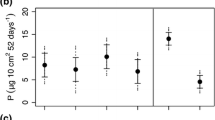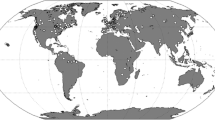Abstract
As an even-aged stand develops growth is concentrated first on leaves and fine roots, as a result nutrient accumulation is very rapid. During this early stage there is a distinct species effect whereas later nutrient uptake becomes a function of growth rate irrespective of species. Once canopy is closed up to two thirds of the nutrients required for growth can be obtained by retranslocation from older or dying tissues, an efficient conservation mechanism that leads to a reduction in the demands that are further reduced by the cycle through the litter layer. In consequence nutritional problems are most likely in the early years while the green crown is being constructed. Later in the rotation problems are unlikely unless nutrient cycles are disturbed, for example by thinning or as a result of excessive accumulation of humus. The eventual clear felling is a major disruption to nutrient cycles. Accelerated litter decomposition can lead to leaching losses, although this can be short lived, and burning if practised can have a major impact on poor sites. Nutrient loss in material removed from the felling site, whether or not harvested, is not high but is much increased if crowns are removed, particularly for the heavily crowned species. The importance of such loss clearly varies with site but may be significant for more than just loss of nitrogen, with loss of calcium, phosphorus or even organic matter per se all being possibly causes of worry.
Similar content being viewed by others
References
Attiwill P J 1979 Nutrient cycling in a Eucalyptus obliqua (L'Herit) forest. III. Growth, biomass and net primary production. Aust. Bot. 27, 439–458.
Ayers A S, Takahashi M and Kanehiro Y 1947 Conversion of non-exchangeable potassium to exchangeable forms in a Hawaiian soil. Soil Sci. Soc. Am. Proc. 11, 175–181.
Becker M 1987 Bilau de santé actuel et rétrospectifdu sapun (Abies alba Mill.) dans les vosages. Ann. Sci. For. 44, 379–402.
Beets P N and Pollock D S 1987 Uptake and accumulation of nitrogen in Pinus radiata stands as related to age and thinning. NZ J. For. Res, 17, 353–371.
Borders J G and Perry D A 1992 The influence of soil texture and aggregation on carbon and nitrogen dynamics in southwestern Oregon forests and clearcuts. Can. J. For. Res. 22, 298–305.
Brown A H F 1974 Nutrient cycles in oakwoods in N W England. In The British Oak. Eds. M GMorris and E HPerring. pp. 141–161. The Botanical Society of the British Isles, Classey, E W Faringdon, England.
Cottam N D 1990 Internal nutrient cycling in evergreen and,deciduous tree species. Unpublished PhD thesis, University of Aberdeen.
Cromer R N and Jarvis P G 1990 Growth and biomass partitioning in Eucalyptus grandis seedlings in response to nitrogen supply. Aust. J. Plant Physiol. 17, 503–515.
Crow M T, Mroz G D and Gale M R 1991 Regrowth and nutrient accumulations following whole-tree harvesting of a maple-oak forest. Can. J. For. Res. 21, 1305–1315.
Curran M P and Ballard T M 1990 Some slashburning effects on soil and trees in British Columbia. In Sustained Productivity of Forest Soils, Proceedings of 7th North American Forest Soils Conference. Eds. S PGessel, D SLacate, G FWeetman and R FPowers. pp 355–361. Forestry Publications, University of British Columbia, Vancouver.
Deng X, Weinbaum S A and Dejong T M 1989 Use of labelled nitrogen to monitor transition in nitrogen dependence from storage to current-year uptake in mature walnut trees. Trees Structure Function 3, 11–16.
Dyck W J and Skinner M F 1990 Potential for productivity decline in New Zealand radiata pine forests. In Sustained Productivity of Forest Soils, Proceeding of 7th North American Forest Soils Conference. Eds. S PGessel, D SLacate, G FWeetman and R FPowers. pp 318–332. Forestry Publications, University of British Columbia, Vancouver.
Ebermayer E 1876 Die gesamk lehre der Waldstreu mit Rücksicht auf die chemische Statik des Waldbaues. J Springer, Berlin.
Ellis R C 1981 The effect of regeneration burning upon the nutrient status of soil in mixed eucalypt/rainforest in southern Tasmania. In Proceedings of Australian Forest Nutrition Workshop, Camberra. CSIRO, Melbourne. p. 328.
Fyles J W, Fyles I H, Beese W J and Feller M C 1991 Forest floor characteristics and soil nitrogen availability on slash-burned sites in coastal British Columbia. Can. J. For. Res. 21, 1516–1522.
Grace J, Allen S J and Wilson C 1989 Climate and the meristem temperatures of plant communities near the tree-line. Oecologia 79, 198–204.
Grace J and Norton D A 1990 Climate and growth of Pinus sylvestris at its upper altitudinal limit in Scotland: evidence from tree growth-rings. J. Ecol. 78, 601–610.
Halopainen T and Heinonen-Tanski H 1992 Effects of different nitrogen sources on the growth of Scots pine seedlings and the ultrastructure and development of their mycorrhizae. Can. J. For. Res. 23, 362–372.
Hornbeck J W, Smith C T, Martin Q W, Tritton L M and Pierce R S 1990 Effects of intensive harvesting on nutrient capitals of three forest types in New England. For. Ecol. Manage. 30, 55–64.
Johnson D W and Todd D E 1990 Nutrient cycling in forests of Walker Branch Watershed, Tennessee; roles of uptake and leaching in causing soil changes. J. Environ. Qual. 19, 97–104.
Jurgensen M F, Harvey A E, Graham R T, Larsen M J, Tonn J R and Page-Dumroese D S 1990 Soil organic matter, timber harvesting, and forest productivity in the inland Northwest. In Eds. S PGessel, D SLacate, G FWeetman and R FPowers. pp 392–415. Forestry Publications, University of British Columbia, Vancouver.
Lim M T and Cousins J E 1986 The internal transfer of nutrients in a Scots pine stand. II. The pattern of transfer and the effects of nitrogen availability. Forestry 59, 17–27.
Lundgren B 1978 Soil conditions and nutrient cycling under natural and plantation forests in Tanzanian highlands. Reports on Forest Ecology and Forest Soils No. 31, Department of Forest Soils, Swedish University of Agricultural Sciences, Uppsala.
MacMillan D C 1991 Predicting the general yield class of Sitka spruce on better quality land in Scotland. Forestry 64, 359–372.
Mayhead G J 1973 The effect of altitude above sea level on the yield class of Sitka spruce. Scot. For. 27, 231–237.
Millard P and Proe M F 1992 Storage and internal cycling of nitrogen in relation to seasonal growth of Sitka spruce. Tree Physiol. 10, 33–43.
Miller H G 1981 Forest fertilisation: some guiding concepts. Forestry 54, 157–167.
Miller H G 1983 Maintenance and improvement of forest productivity: an overview. In ILTFRO Symposium on Forest Site and Continuous Productivity. Eds. R Ballard and S P Gessel. USDA forest Service General Technical Report PNW-163, 280–285.
Miller H G 1984 Dynamics of nutrient cycling in plantation ecosystems. In Wood for Energy: the Implications for Harvesting, Utilisation and Marketing. Ed. J RAldous. pp 137–146. Institute of Chartered Foresters, Edinburgh.
Miller H G 1986 Carbon × nutrient interactions — the limitations to productivity. Tree Physiol. 2, 373–385.
Miller H G 1987 Nutrient control of growth in temperate forests. In The Temperate Forest Ecosystem. Eds. Yang Haxi, Wang Zhan, I N R Jeffers and P A Ward. pp 147–152. ITE Symposium 20, Institute of Terrestrial Ecology, Grange-over-sands, Cumbria.
Miller H G 1989 Internal and external cycling of nutrients in forest stands. In Biomass Production by Fast-Growing Trees. Eds. J S Pereira and J JLandsberg. pp 73–80. Kluwer Academic Press, Dordrecht.
Miller H G, Cooper J M and Miller J D 1976 Effect of nitrogen supply on nutrients in litter fall and crown leaching in a stand of Corsican pine. J. Appl. Ecol. 13, 238–248.
Miller H G, Cooper J M and Miller J D 1992 Response of pole-stage Sitka spruce to applications of fertiliser nitrogen, phosphorus and potassium in upland Britain. Forestry 65, 15–33.
Miller H G, Copper J M, Miller J D and Pauline O J L 1979 Nutrient cycles in pine and their adaptation to poor soils. Can. J. For. Res. 9, 19–26.
Miller H G and Miller J D 1976 Effect of nitrogen supply on net primary production in Corsican pine. J. Appl. Ecol. 13, 249–256.
Miller H G and Miller J D 1987 Nutritional requirements of Sitka spruce. Proc. R. Soc. Edinburgh 93B, 75–83.
Miller H G and Miller J D 1991 Energy forestry: the nutrition equation. In Wood for Energy: the Implications for Harvesting, Utilisation and Marketing. Ed. J RAldous. pp 137–147. Institute of Chartered Foresters, Edinburgh.
Miller H G, Miller J D and Cooper J M 1980 Biomass and nutrient accumulation at different growth rates in thinned plantations of Corsican pine. forestry 53, 23–39.
Miller H G and Proe M F 1986 Nutrient flow modelling. In Computers in Forestry. Eds. W LMason and RMutezelfeldt. pp 228–237. Institute of Chartered Foresters, Edinburgh.
Miller R E and Bigley R E 1990 Effects of burning Douglas-fir logging slash on stand development and site productivity. In Sustained Productivity of Forest Soils, Proceedings of 7th North American Forest Soils Conference. Eds. S PGessel, D SLacate, G FWeetman and R FPowers. pp 362–376. Forestry Publications, University of British Columbia, Vancouver.
Nambiar E K S and Fife D N 1987 Growth and nutrient translocation in needles of radiata pine in relation to nitrogen supply. Ann. Bot. 60, 147–156.
Nambiar E K S and Fife D N 1991 Nutrient retranslocation in temperate conifers. Tree Physiol. 9, 185–207.
Nommik H 1966 The uptake and translocation of fertiliser 15N in young trees of Scots pine and Norway spruce. Stud. For. Suec. 35, 1–18.
Pastor J and Bockheim J D 1984 Distribution and cycling of nutrients in an aspen-mixed-hardwood-spodosol ecosystem in northern Wisconsin. Ecology 65, 339–353.
Rehfuess K E and Schmidt A 1971 Die Wirkung von Lupinenunterbau and Kalkammonsalpeterdüngung auf den Ernähnungszustand in der Oberp. Forstwiss, Centralblatt. 90, 237–259.
Rennie P J 1955 The uptake of nutrients by mature forest growth. Plant and Soil 7, 49–95.
Roberts T M, Skeffngton R A F and Bland L W 1989 Causes of type 1 spruce decline in Europe. Forestry 62, 179–222.
Slegemoeller K A and Chappell H N 1991 Effects of fertilisation and thinning on 8-year growth responses of second-growth Douglas fir stands. Can. For. Res. 21, 516–521.
Squire R O and Flinn D W 1981 Site disturbance and nutrient economy of plantations with special reference to Radiata pine on sands. In Proceedings of Australian Forest Nutrition Workshop, Canberra. pp 291–302. CSIRO Melbourne.
Switzer G L and Nelson L E 1972 Nutrient accumulation and cycling in loblolly pine (Pinus taeda 1.) plantation ecosystems: the first twenty years. Proc. Soil Sci. Soc. Am. 36, 143–147.
Turner J 1977 Effect of nitrogen availability on nitrogen cycling in a Douglas-fir stand. For. Sci. 23, 307–316.
Turner J and Singer M J 1976 Nutrient distribution and cycling in a sub-alpine coniferous forest ecosystem. J. Appl. Ecol. 13, 295–301.
VanMiegroet H, Cole D W and Homann P S 1990 The effect of alder forest cover and alder forest conversion on site fertility and productivity. In Sustained Productivity of Forest Soils, Proceedings of 7th North American Forest Soils Conference. Eds. S PGessel, D SLacate, G FWeetman and R FPowers. pp 333–354. Forest Publications, University of British Columbia, Vancouver.
Weetman G F 1962 Nitrogen relations in a black spruce (Picea mariana Mill.) stand subject to various fertiliser and soil treatments. Pulp and Paper Research Institute of Canada, Woodlands Research Index 129.
Weetman G F and Webber B 1972 The influence of wood harvesting on the nutrient status of two spruce stands. Can. J. For. Res. 2, 351–369.
Worrell R 1987 Productivity of Sitka spruce on upland sites in northern Britain. Forestry Commission Bulletin No. 72, HMSO, London.
Author information
Authors and Affiliations
Rights and permissions
About this article
Cite this article
Miller, H.G. The influence of stand development on nutrient demand, growth and allocation. Plant Soil 168, 225–232 (1995). https://doi.org/10.1007/BF00029332
Issue Date:
DOI: https://doi.org/10.1007/BF00029332




